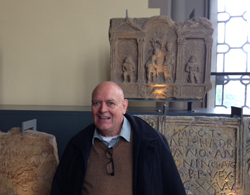Hunterian distance slab reunited with finder after 50 years
Published: 29 June 2015
Staff at The Hunterian were delighted to hear from an old friend this week.
 Staff at The Hunterian were delighted to hear from an old friend this week.
Staff at The Hunterian were delighted to hear from an old friend this week.
Donald McInnes recently visited the Hunterian Museum with relatives from the USA and Canada to show them the extensive collection of Roman artefacts and treasures found in Scotland.
Mr McInnes particularly wanted to show his family the inscribed distance slab of the twentieth region, c. 142-43 AD, also known as the triumphant march through the archway tablet, which forms part of our Antonine Wall display.
The tablet was unearthed by Mr McInnes in 1965 as a young man working on Cleddans Farm in West Dunbartonshire. Mr McInnes said:
‘I was ploughing the field at the time when the plough fetched up on what I thought was a large rock. I stopped immediately to inspect the damage I thought the rock might have done to the plough but soon realized this was not any rock but something unusual and needed further inspection.
With the help of others and using the tractor, we were able to raise the stone and take it back to the farm to be cleaned. We were so amazed to see the transformation as the dirt and mud was carefully removed.’
The stone was later presented to the University of Glasgow by the farmer Ian McIndeor. It is thought that there was a Roman road in the locality where the stone was found which probably went right through the field. Mr McInnes continued:
‘I am very proud of this discovery and especially to see it displayed in the amazing Hunterian Museum.’
Built around AD 142 in the reign of the Roman emperor Antoninus Pius, the Antonine Wall ran coast-to-coast across Scotland from the Clyde to the Firth of Forth.
The Antonine Wall distance slabs were designed to record lengths or distances of the wall completed by each legion. The carved iconography celebrates Roman military victories. Placed on the south side of the wall they acted as powerful political propaganda.
The carved stone slab discovered by Mr McInnes symbolises Roman victory over the Caledonian tribes. 16 of the 18 surviving slabs from the Antonine Wall are on display in the Hunterian Museum.
First published: 29 June 2015
<< News Archive

